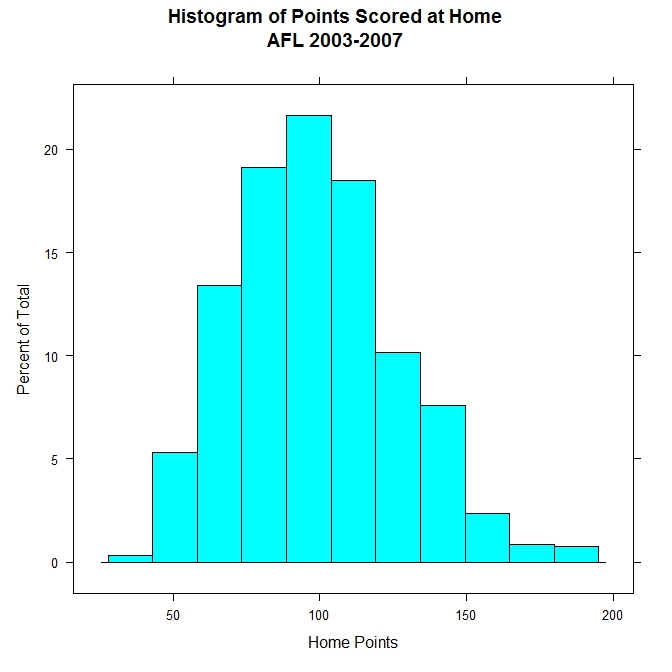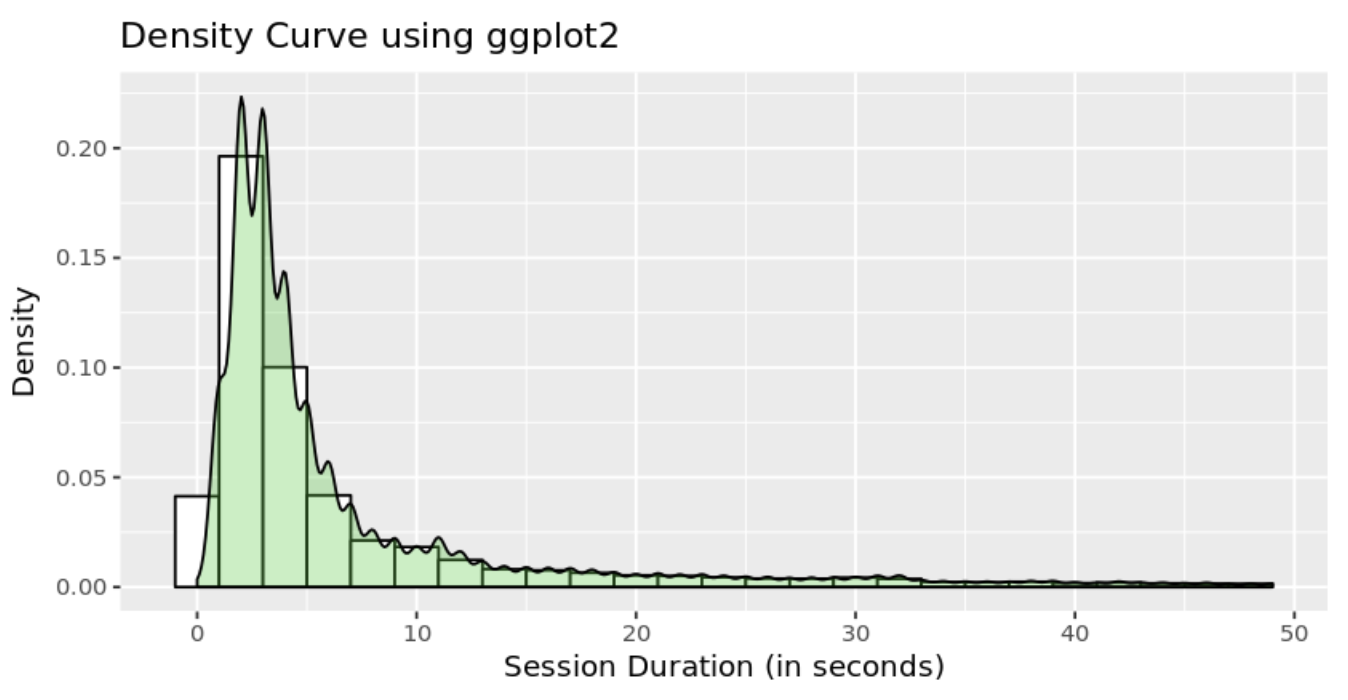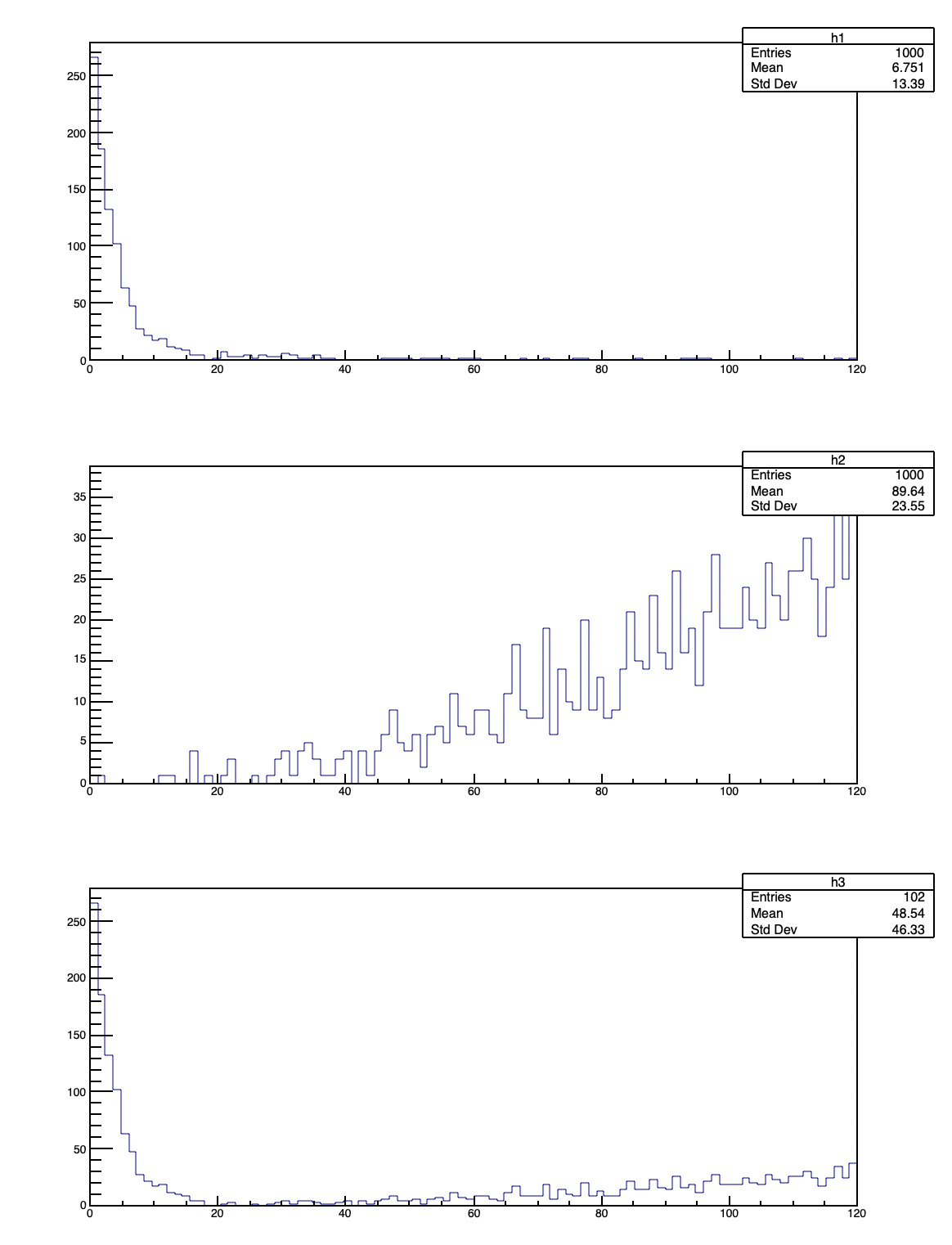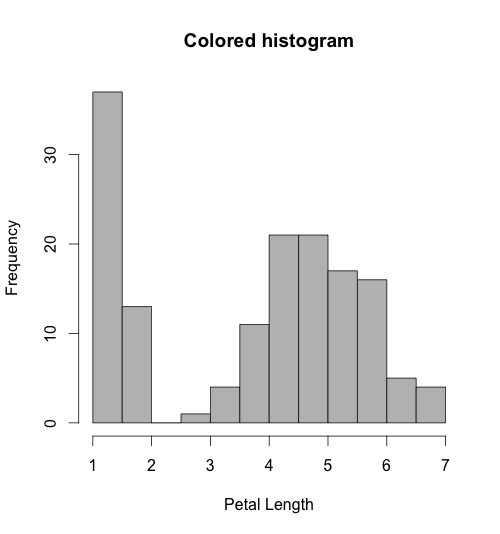38 r histogram axis labels
Histograms in R language - GeeksforGeeks xlab: This parameter is the label for horizontal axis. border: This parameter is used to set border color of each bar. xlim: This parameter is used for plotting values of x-axis. ylim: This parameter is used for plotting values of y-axis. breaks: This parameter is used as width of each bar. Creating a simple Histogram in R Modify axis, legend, and plot labels using ggplot2 in R Adding axis labels and main title in the plot By default, R will use the variables provided in the Data Frame as the labels of the axis. We can modify them and change their appearance easily. The functions which are used to change axis labels are : xlab ( ) : For the horizontal axis. ylab ( ) : For the vertical axis.
Label the x axis correct in a histogram in R - Stack Overflow You have to plot the labels at the histogram bin midpoints. If you want to remove the axis and just have lettering, the padj will move the letters closer to the axis which you just removed. h <- hist(InsectSprays$count, plot = FALSE) plot(h, xaxt = "n", xlab = "Insect Sprays", ylab = "Counts", main = "", col = "pink") axis(1, h$mids, labels = LETTERS[1:6], tick = FALSE, padj= -1.5)

R histogram axis labels
r - Create custom x-axis labels for hist() - Stack Overflow I am using the code below to create a histogram. I've tried replacing the x-axis values using the axis code, but nothing happens other than my x-axis ends up with no labels. Does anyone have any . Stack Overflow. ... Insert X-axis labels into an R histogram (base hist package) Data Visualization with R - Histogram - Rsquared Academy add labels to the bars A histogram is a plot that can be used to examine the shape and spread of continuous data. It looks very similar to a bar graph and can be used to detect outliers and skewness in data. The histogram graphically shows the following: center (location) of the data spread (dispersion) of the data skewness outliers Display All X-Axis Labels of Barplot in R (2 Examples) There are basically two major tricks, when we want to show all axis labels: We can change the angle of our axis labels using the las argument. We can decrease the font size of the axis labels using the cex.names argument. Let's do both in R: barplot ( data$value ~ data$group, # Modify x-axis labels las = 2 , cex.names = 0.7)
R histogram axis labels. Learn How to Create a Histogram Using R Software - EDUCBA R uses hist function to create histograms. This hist function uses a vector of values to plot the histogram. Histogram comprises of an x-axis range of continuous values, y-axis plots frequent values of data in the x-axis with bars of variations of heights. Syntax: The syntax for creating histogram is 8.11 Removing Axis Labels | R Graphics Cookbook, 2nd edition This cookbook contains more than 150 recipes to help scientists, engineers, programmers, and data analysts generate high-quality graphs quickly—without having to comb through all the details of R's graphing systems. Each recipe tackles a specific problem with a solution you can apply to your own project and includes a discussion of how and why the recipe works. Histogram in R Programming - Tutorial Gateway In this example, we remove the X-Axis, Y-Axis, and how to assign labels to each bar in the rstudio histogram using axes, ann, and labels argument. axes: It is a Boolean argument. If it is TRUE, the axis is drawn. labels: It is a Boolean argument. If it is TRUE, it returns the value on top of each bar. ann: It is a Boolean argument. How to set the X-axis labels in histogram using ggplot2 at the center in R? Loading ggplot2 package and creating the histogram − Example > library(ggplot2) > ggplot(df,aes(x))+ geom_histogram(binwidth=1) Output Creating the histogram with X-axis labels at the center − Example >ggplot(df,aes(x))+geom_histogram(binwidth=1,boundary=-0.5)+ scale_x_continuous(breaks=1:11) Output Nizamuddin Siddiqui
Lattice Histogram in R - Tutorial Gateway xlab: Please specify the label for the X-Axis ylab: Please specify the label for the Y-Axis # Assign Names to R Lattice package Histogram # Importing the lattice library library (lattice) # Creating Plot histogram (~ Sepal.Length, data = iris, main = "R Lattice Histogram", xlab = "Length", ylab = "Total Percentage") How to apply manually created x-axis labels in a histogram created by ... Therefore, firstly we need to create the histogram by ignoring the labels and then axis function can be used for new values. Consider the below vector x and create a histogram of x by ignoring x-axis labels − Example set.seed(1999) x<-rnorm(5000,9,1) hist(x,xaxt='n') Output Now adding new values for x-axis labels − Example R Histogram - Base Graph - Learn By Example In R, you can create a histogram using the hist () function. It has many options and arguments to control many things, such as bin size, labels, titles and colors. Syntax The syntax for the hist () function is: hist ( x, breaks, freq, labels, density, angle, col, border, main, xlab, ylab, …) Parameters Create a Histogram Draw Plot with Multi-Row X-Axis Labels in R (2 Examples) This moves the axis labels to a vertically lower position and avoid overlap with the first axis row. Let's execute the code: plot ( data$x, # Draw Base R plot with multiple axes data$y, type = "o" , xlab = "" , xaxt = "n") axis (1, 1: nrow ( data), data$axis1) axis (1, 1: nrow ( data), data$axis2, line = 2.5)
R hist() to Create Histograms (With Numerous Examples) Example 3: Use Histogram return values for labels using text () h <- hist (Temperature,ylim=c (0,40)) text (h$mids,h$counts,labels=h$counts, adj=c (0.5, -0.5)) Defining the Number of Breaks With the breaks argument we can specify the number of cells we want in the histogram. However, this number is just a suggestion. hist: Histograms - R Package Documentation main title and axis labels: these arguments to title() get "smart" defaults here, e.g., the default ylab is "Frequency" iff freq is true. xlim, ylim: the range of x and y values with sensible defaults. Note that xlim is not used to define the histogram (breaks), but only for plotting (when plot = TRUE). axes: logical. Density histogram in R | R CHARTS Titles and labels A basic density histogram The hist function creates frequency histograms by default. You can override this behaviour by setting prob = TRUE or freq = FALSE. # Sample data (normal) set.seed(1) x <- rnorm(400) # Histogram hist(x, prob = TRUE) hist(x, freq = FALSE) # Equivalent Color of the histogram R: Histograms main title and axis labels: these arguments to title() get "smart" defaults here, e.g., the default ylab is "Frequency" iff freq is true. xlim, ylim: the range of x and y values with sensible defaults. Note that xlim is not used to define the histogram (breaks), but only for plotting (when plot = TRUE). axes: logical.
Axis labels in R plots using expression() command lab - axis labels. main - main title. sub - sub-title. You specify the font face as an integer: 1 = Plain. 2 = Bold. 3 = Italic. 4 = Bold & Italic. You can set the font face(s) from par() or as part of the plotting command. This is useful for the entire label/title but does not allow for mixed font faces.
How to Make a Histogram with Basic R - R-bloggers This code computes a histogram of the data values from the dataset AirPassengers, gives it "Histogram for Air Passengers" as title, labels the x-axis as "Passengers", gives a blue border and a green color to the bins, while limiting the x-axis from 100 to 700, rotating the values printed on the y-axis by 1 and changing the bin-width to 5.
Axis-labeling in R histogram and density plots ... - Stack Overflow I have two related problems. Problem 1: I'm currently using the code below to generate a histogram overlayed with a density plot: hist (x,prob=T,col="gray") axis (side=1, at=seq (0,100, 20), labels=seq (0,100,20)) lines (density (x)) I've pasted the data (i.e. x above) here. I have two issues with the code as it stands: the last tick and label ...
Axes customization in R | R CHARTS You can remove the axis labels with two different methods: Option 1. Set the xlab and ylab arguments to "", NA or NULL. # Delete labels plot(x, y, pch = 19, xlab = "", # Also NA or NULL ylab = "") # Also NA or NULL Option 2. Set the argument ann to FALSE. This will override the label names if provided.
Making Histograms in R - Washtenaw Community College Just the simple command, hist(L1) given in Figure 1 produces the histogram shown in Figure 2. Figure 2 Unlike our first bar chart this histogram fills in some fields for us. In particular, we have a title for the graph, along with labels for both the x-axis and the y-axis. Of course, if we want to we can override those values and set the labels to text that we want.
Rotate Axis Labels of Base R Plot (3 Examples) The axis labels of the x-axis have a horizontal orientation and the y-axis labels have a vertical orientation. Example 1: Rotate Axis Labels Horizontally. In order to change the angle of the axis labels of a Base R plot, we can use the las argument of the plot function. If we want to rotate our axis labels to a horizontal position, we have to specify las = 1:
R: Plot Histograms - Massachusetts Institute of Technology axes: logical, indicating if axes should be drawn. labels: logical or character. Additionally draw labels on top of bars, if not FALSE; if TRUE, draw the counts or rounded densities; if labels is a character, draw itself. add: logical. If TRUE, only the bars are added to the current plot. This is what lines.histogram(*) does. ann: logical.
ggplot2 axis ticks : A guide to customize tick marks and labels labels : labels of axis tick marks. Allowed values are : NULL for no labels waiver () for the default labels character vector to be used for break labels limits : a character vector indicating the data range Note that, in the examples below, we'll use only the functions scale_x_discrete () and xlim () to customize x axis tick marks.
R: Plot Histograms axes: logical, indicating if axes should be drawn. labels: logical or character. Additionally draw labels on top of bars, if not FALSE; if TRUE, draw the counts or rounded densities; if labels is a character, draw itself. add: logical. If TRUE, only the bars are added to the current plot. This is what lines.histogram(*) does. ann: logical.
Display All X-Axis Labels of Barplot in R (2 Examples) There are basically two major tricks, when we want to show all axis labels: We can change the angle of our axis labels using the las argument. We can decrease the font size of the axis labels using the cex.names argument. Let's do both in R: barplot ( data$value ~ data$group, # Modify x-axis labels las = 2 , cex.names = 0.7)
Data Visualization with R - Histogram - Rsquared Academy add labels to the bars A histogram is a plot that can be used to examine the shape and spread of continuous data. It looks very similar to a bar graph and can be used to detect outliers and skewness in data. The histogram graphically shows the following: center (location) of the data spread (dispersion) of the data skewness outliers
r - Create custom x-axis labels for hist() - Stack Overflow I am using the code below to create a histogram. I've tried replacing the x-axis values using the axis code, but nothing happens other than my x-axis ends up with no labels. Does anyone have any . Stack Overflow. ... Insert X-axis labels into an R histogram (base hist package)













Post a Comment for "38 r histogram axis labels"